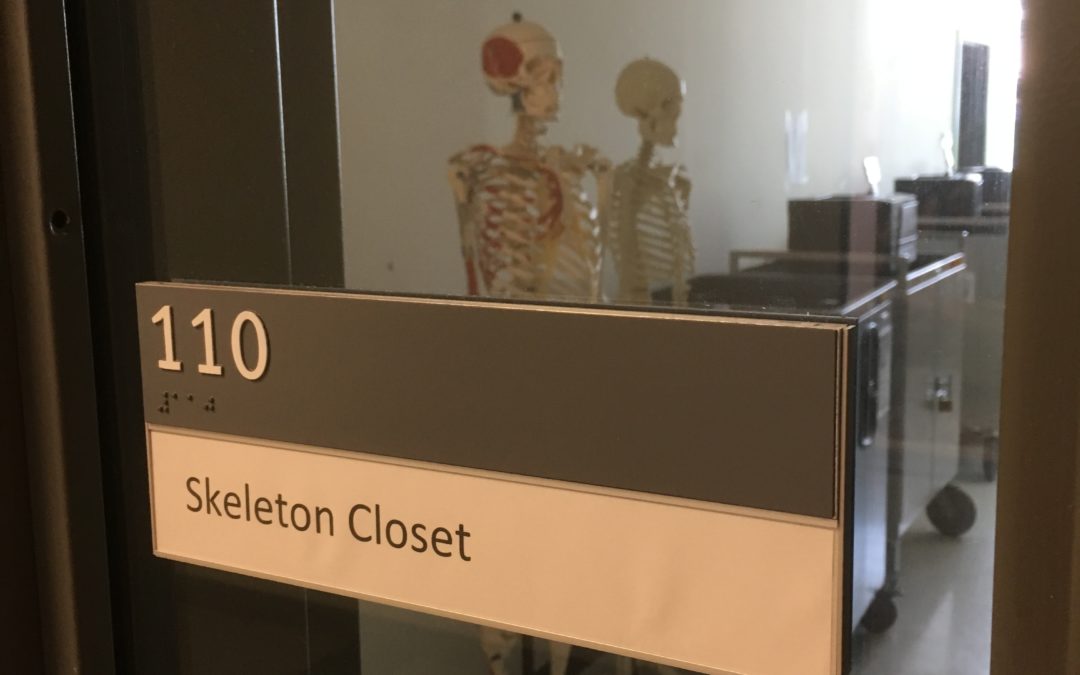So THAT’s where they keep them!
I snapped this hilarious photo at Montgomery College, the community college where my daughter is taking a class this week, as part of the college’s youth summer programs (summer camps).
All of us have skeletons in our closet: those things that we don’t want other people to know, that we don’t want to admit, or that bring us discomfort or shame. Some of our skeletons are silly, some are scary, and some keep us frozen in place, unable to move forward in health, career, or relationships.
People usually talk about “skeletons in the closet” when it comes to theirs (or other people’s) personal lives. This photo got me thinking about skeletons in people’s professional lives. What secrets are we keeping inside that could be holding us back from greatness as professional leaders? I’m not talking about things you’ve done, or that your organization has done, that might be unethical or illegal. I’m talking about something more subtle – the hidden beliefs, skill deficits, or lack of faith in ourselves and others that we do not want anyone to find out about.
Skeletons in Your Professional Leadership Closet:
- Are there things you think you are not good at? How hard are you working to hide them?
- Do you think your voice matters to your colleagues?
- Do you wish you were doing something different – a different office, a different role, a different career?
- Are you bored at work?
- Do you think that stress = success?
- Do you secretly detest the thing that you do best?
- Do you have a completely different persona inside and outside the office? Do you feel you have to put on a “mask” every time you walk into work or client meetings?
- Do you believe in your organization’s mission?
What secrets are we keeping inside that could be holding us back from greatness as professional leaders?
Skeletons in Your Organizational Closet:
- Has your organization gotten away from what it does best, just to chase the mighty dollar?
- Is your organization providing a *real* benefit to clients or customers, or does it sometimes sell or promote things that people don’t want or need?
- Is your organization really necessary?
- Does your organization like its clients/customers? Care about them? Believe in their wisdom and their potential?
- Is your organization moving the needle – creating change and/or adding value?
- Is there something your organization does poorly, that it’s scrambling to cover up?
- Does your organization promote itself in an honest and fair way?
Once you know what the skeletons are, what can you do about it?
Sometimes, the best first step is just to acknowledge that they are there. You can’t change everything about yourself and your organization on your own… but you can change how YOU relate to these skeletons. Let’s say one of your professional leadership skeletons has to do with your relationships with your colleagues. Perhaps you secretly believe that they do not respect your opinion, do not notice you, or do not take you seriously, and that hidden belief has been holding you back. Finding out if it’s true and attempting to “fix” the problem may not be possible, and your attempts to “fix” it might have unintended, negative results. Just start by noticing: When does this belief come up? In what context? How often, and with whom? If you train yourself to just notice it the belief and the circumstances that trigger it, the belief could start to dissipate. And, if it is, indeed, a problem that needs to be address, your detached, non-reactionary noticing will change your demeanor in ways that will start to shift those relationships with colleagues.
What about your organization’s skeletons? Let’s say your organization suffers from “mission creep” – it starts doing things that are not central to the mission, maybe because someone was paying for the organization to do it, or because it became trendy. Because it’s not central to the mission, other important things in the organization are suffering. You, as an individual, might not be able to do anything about that on your own. But you can take note of it. You can see where you might be contributing to the mission creep. You can renew your own attention, energy, and creativity towards things that are more mission aligned. You can mention your newfound alignment to trusted colleagues. This could start to subtly shift attention and resources in your organization towards the things that matter most.
Skeletons don’t form overnight. Decay takes time. It takes time to figure out what your skeletons are, and then turn your attention to them. Step one: finding the “Skeleton Closet.” If only it could be in a clearly marked room, like this one at the college! The good news is, you’ve already got the keys.
Originally published at pitchconsulting.com


